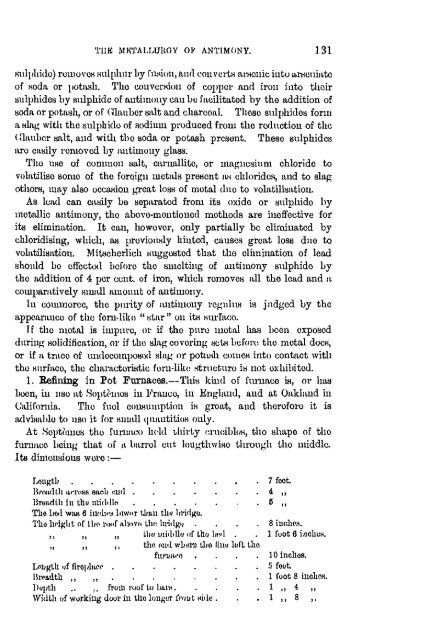A N T I M O N Y : ITS HISTORY, CHEMISTRY, MINERALOGY ...
A N T I M O N Y : ITS HISTORY, CHEMISTRY, MINERALOGY ...
A N T I M O N Y : ITS HISTORY, CHEMISTRY, MINERALOGY ...
Create successful ePaper yourself
Turn your PDF publications into a flip-book with our unique Google optimized e-Paper software.
TIIK METALLURGY OK ANTIMONY. 131<br />
sulphide) removes sulphur by fusion, and converts arsenic intoarseniatc<br />
of soda or potash. Tho conversion of copper and iron into their<br />
sulphides by sulphide of antimony can be facilitated by the addition of<br />
soda or potash, or of (Glauber salt and charcoal. Those sulphides form<br />
a slag with the sulphide of sodium produced from tho reduction of the<br />
(Jlaubor salt, and with the soda or potash present. These sulphides<br />
are easily removed by antimony glass.<br />
The use of common salt, carnallito, or magnesium chloride to<br />
volatilise some of the forQign metals present as chlorides, and to slap;<br />
others, may also occasion great loss of metal duo to volatilisation.<br />
As lead can easily be separated from its oxido or sulphide by<br />
motallic antimony, tho above-mentioned methods are ineffective for<br />
its elimination. It can, howevor, only partially be eliminated by<br />
chloridising, which, as previously hinted, causes groat loss due to<br />
volatilisation. Mitscherlich suggestod that tho elimination of lead<br />
should be effected before tho smelting of antimony sulphide by<br />
the addition of 4 per cent, of iron, which removes all the lead and a<br />
comparatively small amount of antimony.<br />
in commerce, the purity of antimony regains is judged by the<br />
appearance of the fern-liko "star" on its surface.<br />
If the metal is impure, or if tho pure metal has been oxposod<br />
during solidification, or if the slag covering sets before tho motal does,<br />
or if a trace of undocomposod slag or potash comes into contact with<br />
tho surfaco, the characteristic fern-liko structure is not exhibited.<br />
1. Refining in Pot Furnaces.—This kind of furnace is, or has<br />
been, in nso at Sopttanos in Franco, in England, and at Oakland in<br />
California. The fuel consumption is groat, and therefore it is<br />
advisable to uso it for small quantities only.<br />
At ttoptumes tho furnaco held thirty orueiblos, tho shape of tho<br />
furnaco being that of a barrel cut lengthwise through tho middle.<br />
Its dimensions were :—<br />
Length 7 foot.<br />
Breadth across each end , . . . . . . 4 ,,<br />
Breadth in the middle . . . . . • . 6 ,,<br />
The bod wan 6 inches luwur than tliu bridge.<br />
The height of tho roofabovo tho bridgn . . . . 8 inches.<br />
,, „ ,, tho middle of tho bed . . 1 foot 6 inches.<br />
,, ,, ,, tho cud whero tho IIuo loft tho<br />
furnace . . . .10 inches.<br />
Length of ftrojvhice 5 foot.<br />
Breadth ,, , 1 foot 8 inchoH,<br />
Dopth ,, ,, from roof to burn. . . . . 1 ,, 4 ,,<br />
Width of working door in tho longer iront Hide . . . 1 ,, 8 ,,

















